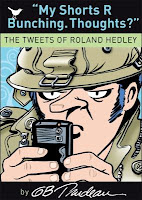 Technology and our ever-shrinking attention spans may be changing the way we keep personal records, but our desire to understand the thoughts and impressions of others is growing. Blogs have replaced diaries. Emails, texts and tweets have replaced letters. Replaced or displaced? Just when you might start to worry about the permanence of social media, there is My Shorts R Bunching. Thoughts: the tweets of Roland Hedley preserved in old fashioned print for all time.
Technology and our ever-shrinking attention spans may be changing the way we keep personal records, but our desire to understand the thoughts and impressions of others is growing. Blogs have replaced diaries. Emails, texts and tweets have replaced letters. Replaced or displaced? Just when you might start to worry about the permanence of social media, there is My Shorts R Bunching. Thoughts: the tweets of Roland Hedley preserved in old fashioned print for all time.
I suppose the difference is that blogs and tweets are meant for indiscriminate public consumption immediately rather than private reflection.
Collections of diaries and letters continue to be published and we continue to enjoy them. Diaries and letters tend to be open candid records of events which haven’t been blurred by time and perspective. They may be accounts of significant events or the minutiae of daily life.
 Periodically we are lucky to stumble upon a diary written by someone who might never have suspected that their life would be of enduring interest. Of course the classic example is Anne Frank: The Diary of a Young Girl. Anne was a young girl who recorded her life during exceptional circumstances. Thomas Cairns Livingstone (Tommy’s War: A First World War Diary 1913-1918) was a middle class, ordinary Glaswegian who did us the favour of recording his impressions of daily life in Glasgow in the beginning of the 20th century. A Victorian Lady’s Album: Kate Shannon’s Halifax and Boston Diary of 1892 is the beautifully illustrated diary of a young articulate woman living in Halifax at the end of the 19th century. A fascinating glimpse of domestic life through the eyes of a woman at the start of her unfortunately short life.
Periodically we are lucky to stumble upon a diary written by someone who might never have suspected that their life would be of enduring interest. Of course the classic example is Anne Frank: The Diary of a Young Girl. Anne was a young girl who recorded her life during exceptional circumstances. Thomas Cairns Livingstone (Tommy’s War: A First World War Diary 1913-1918) was a middle class, ordinary Glaswegian who did us the favour of recording his impressions of daily life in Glasgow in the beginning of the 20th century. A Victorian Lady’s Album: Kate Shannon’s Halifax and Boston Diary of 1892 is the beautifully illustrated diary of a young articulate woman living in Halifax at the end of the 19th century. A fascinating glimpse of domestic life through the eyes of a woman at the start of her unfortunately short life.
 Collections of correspondence may not be as candid (or perhaps they might, depending on the author!) as diaries. What they do offer is a view of a relationship as it grows and changes over time. The Mitfords: letters between six sisters covers the correspondence of the Mitford sisters between 1925 and 2002. The sisters were highly connected, from a young age, with the political and literary world. Their politics were varied (fascist, Nazi sympathizer, communist) and their relationships often strained. The letters provide a fascinating look at 20th century history. Considering the company the Mitford sisters kept, they would certainly have expected that their letters would be published one day.
Collections of correspondence may not be as candid (or perhaps they might, depending on the author!) as diaries. What they do offer is a view of a relationship as it grows and changes over time. The Mitfords: letters between six sisters covers the correspondence of the Mitford sisters between 1925 and 2002. The sisters were highly connected, from a young age, with the political and literary world. Their politics were varied (fascist, Nazi sympathizer, communist) and their relationships often strained. The letters provide a fascinating look at 20th century history. Considering the company the Mitford sisters kept, they would certainly have expected that their letters would be published one day.
 Several of the Mitford sisters were successful writers. Not surprisingly, writers make excellent correspondents. Novelist Elizabeth Bowen (Love’s Civil War: Elizabeth Bowen and Charles Ritchie, Letters and Diaries, 1941-1973 ) and Canadian diplomat Charles Ritchie were star crossed lovers. Each married to another, they engaged in a lifelong love affair, at a distance most of the time, described in their letters and journals.
Several of the Mitford sisters were successful writers. Not surprisingly, writers make excellent correspondents. Novelist Elizabeth Bowen (Love’s Civil War: Elizabeth Bowen and Charles Ritchie, Letters and Diaries, 1941-1973 ) and Canadian diplomat Charles Ritchie were star crossed lovers. Each married to another, they engaged in a lifelong love affair, at a distance most of the time, described in their letters and journals.
 Lifelong friendships can be cultivated and maintained through correspondence as found in Selected Letters by May Sarton. Sarton pursued friendships with many other well-known 20th century writers through letters. Sarton was free with her emotions and ideas in her letters making them a welcome event for their recipients.
Lifelong friendships can be cultivated and maintained through correspondence as found in Selected Letters by May Sarton. Sarton pursued friendships with many other well-known 20th century writers through letters. Sarton was free with her emotions and ideas in her letters making them a welcome event for their recipients.


